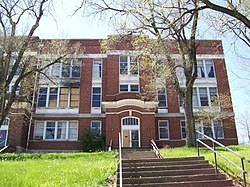| Wyman School | |
| U.S. National Register of Historic Places | |
 Old Wyman School, September 2012 Old Wyman School, September 2012 | |
  | |
| Location | 100 Dunbar St., Excelsior Springs, Missouri |
|---|---|
| Coordinates | 39°20′42″N 94°13′42″W / 39.34500°N 94.22833°W / 39.34500; -94.22833 |
| Area | 1.8 acres (0.73 ha) |
| Built | 1912 (1912) |
| Architectural style | Classical Revival |
| NRHP reference No. | 08000695 |
| Added to NRHP | July 24, 2008 |
Wyman School, also known as Excelsior Springs High School (and later Wyman Public/Elementary School until the mid-1990s), is a historic school building located at Excelsior Springs, Clay County, Missouri.
History
The school was built in 1912. The building is a three-story, rectangular brick building with Classical Revival design elements. It has a flat roof and sits in a limestone foundation. Also on the property is the contributing power plant (1913) and a classroom annex (a non-historic prefabricated building that sits west of the power plant).
The Wyman School was named after Anson Wyman, founder of Excelsior Springs.
The school was eventually converted to an elementary school.
After classes ended in the mid-1990s, the building was used as a community theatre before becoming vacant.
The Wyman School was purchased by the city of Excelsior Springs.
It was listed on the National Register of Historic Places in 2008.
On July 5, 2022, the power plant on the south end of the school was demolished. This structure was built in 1913 to provide heat via a coal-burning furnace. Due to a partial roof collapse noted in 2008 and the extent of damage discovered during a 2021 environmental study, the city decided to demolish the power plant structure.
References
- ^ "National Register Information System". National Register of Historic Places. National Park Service. July 9, 2010.
- ^ Cole, S. Jason (2023-09-17). "Powering Down: Wyman School 'Power Plant' Demolished". Excelsior Citizen. Retrieved 2023-09-19.
- ^ Woodson, W.H. (1920). History of Clay County, Missouri. Topeka, Kansas: Historical Publishing Company. pp. 174–188.
- Elizabeth Rosin and Kristen Ottesen (March 2008). "National Register of Historic Places Inventory Nomination Form: Wyman School" (PDF). Missouri Department of Natural Resources. Retrieved 2016-11-01.
- "Jim and Ruth Arnold own WYMAN PLACE, the former Wyman School". The Excelsior Springs Standard. 1997-03-05. p. 7.
- Rice, Bryan (2022-07-08). "Wyman power plant demolished". Excelsior Springs Standard. Retrieved 2023-09-19.
This article about a property in Clay County, Missouri on the National Register of Historic Places is a stub. You can help Misplaced Pages by expanding it. |
- School buildings on the National Register of Historic Places in Missouri
- Neoclassical architecture in Missouri
- School buildings completed in 1912
- Buildings and structures in Clay County, Missouri
- National Register of Historic Places in Clay County, Missouri
- 1912 establishments in Missouri
- Kansas City, Missouri region Registered Historic Place stubs

